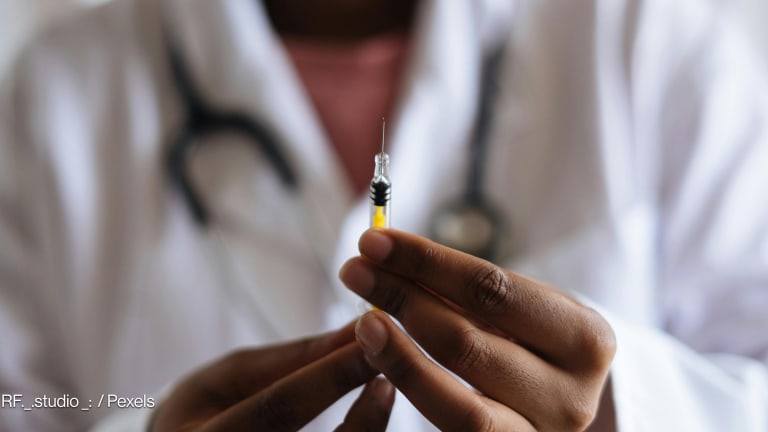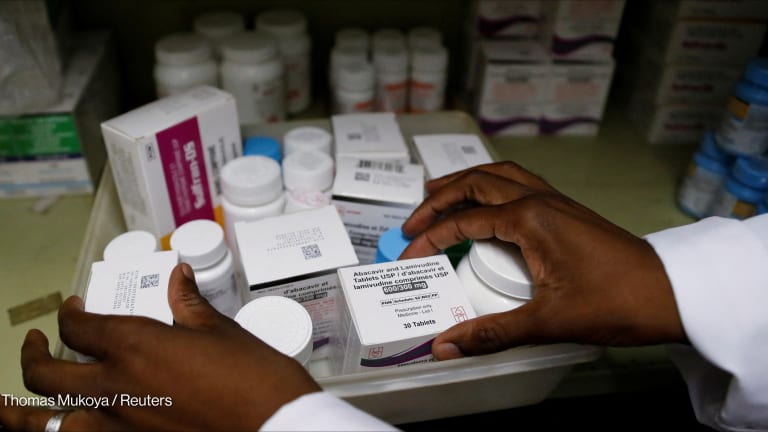
NAIROBI — On a recent afternoon, 19-year old Peter was approached by an NGO worker at the Kahawa West County Market on the outskirts of Nairobi who told him that around the corner he could grab a free take home HIV self-test. He walked over to a white tent to pick up his test and headed home to take it. Although sexually active in a country with one of the largest HIV epidemics in the world, this is the first time he has tested for the virus — even though he has been curious about his status for years.
“I prefer to take the test at home in private,” he said.
People like Peter, whose name has been changed for privacy reasons, risk falling through the cracks of the health care system for a variety of reasons, including the stigma surrounding HIV and the hassles associated with visiting clinics, including taking time off of work.
“Self-care is an untapped potential. It is the ultimate in task-shifting.”
— Dr. Manjulaa Narasimhan, scientist, WHOBut some in the public health sector are hoping that new self-care interventions, like the take-home HIV test, could provide services to populations that have been difficult to reach with a traditional health systems approach.
Self-care interventions could help countries in efforts to achieve universal health coverage — by lessening the workload for health workers, and reaching people who either can’t access or don’t want to come into health facilities.
“Self-care is an untapped potential,” said Dr. Manjulaa Narasimhan, a scientist at the Department of Sexual and Reproductive Health at the World Health Organization. “It is the ultimate in task-shifting. You are task-shifting to people and trusting them with quality interventions.”
Meeting people where they are
This HIV self-test kit giveaway was organized by Population Services Kenya and The Link Empowerment Initiative Githurai. The organizations pick different locations to distribute the kits around Nairobi, as well as the city of Kisumu, in Western Kenya. They specifically target men like Peter because this is a demographic that is not coming into clinics to get tested for HIV. Instead, the organizations have decided to reach out to these men — in places such as bus stops, soccer fields, and markets.
The organizations have set up shop in these locations and have community mobilizers telling their targeted audience about the free tests. At the distribution tent, people are given demonstrations on how to use the tests and given the option to either test with a health professional in a private area of the tent or take the kit home with them. They’ve been doing this since last October.
Instead of going to a clinic, people can pick up products like these at pharmacies or distribution points that are funded by organizations and local governments. Often included with the services are information about what type of care a person might need after using them — such as if a person tests positive for HIV. In Kenya, the test kit includes the number of a hotline for people to call for counseling and more information.
First WHO guideline on self-care
In June last year, WHO published its first guideline on self-care interventions for health, focused specifically on sexual and reproductive health and rights.
Beyond HIV self-testing, other interventions mentioned in the guideline include HPV take-home tests; self-injectable contraceptives; self-sampling to identify sexually transmitted infections, including Neisseria gonorrhoeae, chlamydia, and syphilis; home-based ovulation predictor kits for women that are attempting to become pregnant; as well as the recommendation that over the counter oral contraceptive pills be made available without a prescription.
This guideline represents a new approach for WHO that supports a move to recognize people as central to their own health, linked to the health systems when needed, according to Narasimhan, lead author of the guideline. Much of the focus in the guideline is on interventions that are currently in transition.
“They are all new interventions that are coming into the market now or already exist,” she said. “Interventions that currently are offered within a health care setting, but that people can use on their own, eventually.”
For example, Sayana Press is the first self-injectable contraceptive for women, protecting them for three months. Older versions of injectable contraceptives had thicker needles and were administered in health facilities. The first pilot of this product was launched in 2014.
Currently, many countries only allow women to access self-injectable contraceptives in limited channels within the health system, according to Rebecca Husband, a senior technical adviser in the sexual and reproductive health department at PSI.
For example, in Zambia, the government only recently approved allowing women to learn how to self-inject contraceptives at public facilities, with clinical staff, but they still can’t learn how to self-inject with community health workers, Husband said.
Countries that have authorized self-injection at a national level include Nigeria, Malawi, Senegal, and Uganda. In these countries, women must first self-inject in front of a provider at least once, before taking two or three doses to inject at home.
In Nigeria, for example, the government expanded the channels of access about a year ago. Now, women can learn how to self-inject with a community health worker, certain types of pharmacy staff, and public and private facility clinicians and nurses, in most, if not all, states, according to Husband.
WHO decided to focus on sexual and reproductive health in its first guideline because this area of health comes with more challenges, Narasimhan said, such as stigma surrounding adolescent girls using contraceptives, as well as around the sexual health of LGBTQ communities. This initial guideline will serve as a foundational document to expand into other areas of self-care such as in noncommunicable diseases and mental health, she said.

Self-care and UHC
A key part of countries reaching universal health coverage is task-shifting health interventions away from health workers to individuals, so that health workers aren’t bogged down with simple procedures, experts say.
“One of the ways to enlarge the health system is task-shifting … there are things that frankly individuals can be responsible for,” Karen Sommer Shalett, director of external relations at PSI told Devex.
At the Milele Integrated Medical Center in Nairobi, Dr. Patrick Mburugu said that testing, including for HPV and HIV, take up the staff’s time, which could instead be used for specialized care that can’t be delegated to individuals.
“When you give people information about what they should expect with their results and they carry the kit with them, it [increases] time for the clinicians to attend to other issues. It helps us to reduce the turnaround time for patients,” Mburugu said.
For diagnostic self-testing, it also keeps negative cases out of the facilities.
“Health providers at clinics have said thank you [to organizations that provide self-care interventions] for keeping the negative results home, because now there is more space in the clinic and more capacity to treat the positive cases,” Sommer Shalett said.
Barriers to access
Even when health facilities are available, there are a variety of reasons people aren’t accessing services. This could include expensive transport costs and long wait times.
“For most public health facilities, there is a long queue, few health care providers, and they are serving a large population. When you go, you have to plan to take the whole day,” said Ammon Allen Otieno, a youth advocate at Women Deliver. “For people dependent on each day’s wages, this is not an option.”
Reducing stigma in health facilities to achieve UHC
Stigma can have a particularly negative impact in a health care setting, seriously undermining prevention or treatment efforts. Luckily, tools are available to help address — and reduce — stigma.
Stigma can also keep people out of facilities: A family member may forbid the visit, an adolescent girl could face criticism for requesting contraceptives, or patients can fear judgment based on factors such as sexual orientation, Narasimhan said.
Self-care also works to help provide the widest possible range of interventions to people so they can make choices that fit their lifestyles, such as providing the option of self-injectable contraceptives to women who may not want to use other options, such as a daily pill or a intrauterine device, Sommer Shalett explained.

Affordability
In Nairobi, pharmacist Wycliffe Samoka said his customers complain about the $5 price tag for a new version of an HIV self-blood test, which was launched in 2017. They instead tend to opt for an older version that costs $2. In theory, this cheaper test can be taken at home also but it requires additional purchases, such as buffer solution. Samoka has this on hand at his pharmacy, so his customers prefer him to administer the test instead, to avoid additional expenses.
The price point is one of the challenges in expanding access to take-home interventions like these. Organizations such as PSI are working to create demand and build markets for these interventions to eventually help bring down prices.
They do this by working with a broad base of organizations on the supply, demand, and policy sides of bringing self-care to individuals. It also works to diagnose market failures and involve the right partners, such as implementers, ministries of health, and other public and private sectors actors, said Sandy Garçon, senior manager for advocacy and communications at PSI.
“The idea is that we create the demand and individuals learn about it. Then they want the product or service and the private sector builds up around it with competitive pricing,” Sommer Shalett said. “It can then survive without aid.”
PSI is also working to convince ministries to use domestic funds on self-care to supplement their UHC plans. This could include subsidizing the cost of the commodities and paying to train public health workers to sensitive communities around these interventions.
“That’s the million-dollar question. The financial and economic considerations of self-care interventions are absolutely critical,” Narasimhan said. “We need to put mechanisms in place so it can remain sustainable for countries and to ensure that particularly vulnerable individuals are not left behind.”








